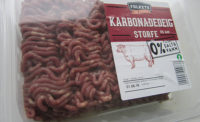American pork processors follow North American Meat Institute (NAMI) specifications, with the shoulder-loin separation made between the second and third rib, and the loin-ham separation made 1.5 inches from the anterior portion of the pelvis, leaving the sirloin attached to the loin. These specifications allow for the greatest potential belly and loin yield, reflecting the popularity of bacon in American markets. Other countries — notably China, Japan and South Korea — make the shoulder-loin separation between the fourth and fifth rib, and the loin-ham separation at the first sacral vertebrae, leaving the sirloin attached to the ham. Although this reduces belly yield, the center section, from which the majority of #1 slices (slices suitable for retail-style packaging) originate, is left intact. The reduction in loin yield is compensated by the increase in shoulder yield, the second most valuable primal in the U.S. domestic market during certain seasons of the year. Potential economic differences between current American fabrication specifications and Asian-inspired specifications are worth investigating as exports are a vital component to the American swine industry. Approximately 23 percent of domestically raised pigs will be exported once slaughtered, with nearly $3 billion in domestic pork sold to China, Japan and South Korea in 2016 alone.
The objective was to compare gross carcass value between pork sides fabricated according to the NAMI specifications (domestic) or Asian-inspired specifications (alternative). Fifteen carcasses from the University of Illinois Meat Science Laboratory were used. One side was fabricated using the domestic fabrication specifications and the other following the alternative fabrication style. Sides were alternated within fabrication style such that both left and right sides were fabricated using both methods to remove any bias associated with workmanship and bilateral symmetry. Alternative-style sides were cut between the fourth and fifth rib and at the first sacral vertebrae to make the shoulder and ham primal pieces. Alternative-style shoulders were further fabricated to yield a cellar trimmed Boston butt, shoulder cushion (triceps brachii), boneless shoulder clod, petite tender and pork brisket. Further fabrication of alternative-style loins, bellies and hams followed NAMI specifications as closely as possible. Primal and subprimal pieces were weighed to allow calculation of cutting yields as a percentage of chilled side weight. Values were determined using the AMS National Carlot Report, with prices reported from the week of April 5, 2013, to the week of April 7, 2017. Best year, worst year and four-year average pricing scenarios were calculated. Pork brisket price was calculated based on the relative price of beef brisket to beef shoulder clod, resulting in an estimated price of $112.83/-cwt.
As expected, there was a decrease in yield of 0.5 percent in the strap off loin and 1.12 percent in the skinned natural fall belly when comparing the domestic-style to alternative-style fabrication method. Also as expected, the same comparison resulted in an increase in yield of 3 percent in the trimmed shoulder. Differences in yields were reflected in the four-year average pricing analysis, where a decrease of $2.20 in the loin and $2.18 in the belly was determined when transitioning from domestic-style to alternative-style fabrication. An increase in shoulder primal value of $6.26 counters these decreases. Overall, there was a net increase of $1.88 per side when sides were fabricated according to alternative-style specifications.
The data collected supports the potential revision of domestic pork specifications. When the potential net increase of $1.88 was extrapolated to the 110 million pigs slaughtered annually in the United States, a possible increase of $206.8 million dollars in revenue for the American swine industry exists. These observations provide a foundation for further investigation into the most advantageous fabrication specifications for the American pork industry. NP




Report Abusive Comment